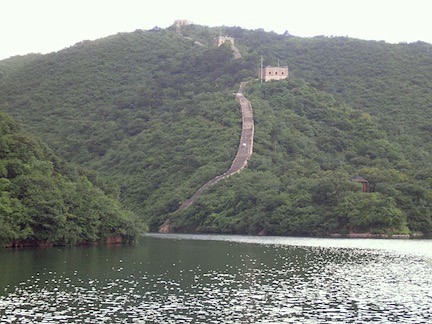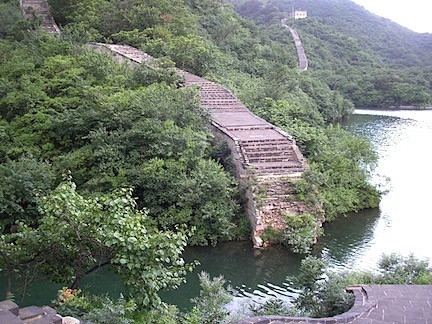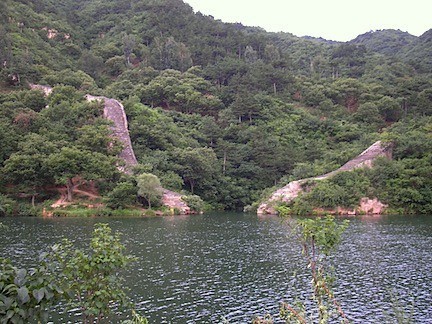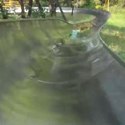Huanghuacheng Lakeside Great Wall Reserve – The Great Wall of China in Water
categories: asia travel
If you have visited the Great Wall of China and are looking for a different view, there is a choice that combines the Chinese feng shui elements of mountains and water in a unique, beautiful setting. It is called the Great Wall in Water.
In past years, my wife and I have visited the Great Wall of China on three previous occasions. Twice we took excursions that included both the Juyong Pass and Badaling sections of the Wall. Both of these sections are must-sees and even though they can be very crowded with tourists, I would still recommend them for a first visit. Last year we decided we wanted to get away from the crowds so we visited the restored Mutianyu section of the Wall. We also enjoyed this more remote section where you can ride a cable car to the top of the mountain and slide back down to the base on a toboggan track sled.

Huanghuacheng Lakeside Great Wall Reserve
This July, my wife and I decided to make a third trek to the Wall so we wanted to visit a section we had not seen before. Based on the recommendations of a few friends in Beijing, we decided to visit the Huanghuacheng Lakeside Great Wall Reserve located in the Huairou District of Beijing City – in English, this section is called either the Waterside Great Wall, Lakeside Great Wall, or Great Wall in Water. What makes this section of the Wall unique is that three sections of the Wall were submerged in water by the construction of the Haoming Lake reservoir. This has created an interesting effect whereby the Wall appears to be descending into the water. In actuality, the Wall has fallen apart where it reaches the water, but nonetheless, the effect is dramatic and unique.

The entrance to the reserve is reached by walking through Xishuiyu Village. After paying an admission fee equivalent to about 5 US dollars, visitors reach the reservoir area by either negotiating a steep stone stairway or by taking a series of long sloping pathways. At the top is the Haoming Lake dam and reservoir. Here you can either walk a pathway across suspension bridges around the reservoir or pay for a scenic boat ride to reach the middle of the park. It is here where you get the best views of the Great Wall submerged in water.

Boat Ride
Generally, the boat ride is on a slow-moving multi-passenger tourist boat, but on the day we visited there were so few people that we traveled on a 9 passenger speed boat. It was actually a lot of fun zooming through the reservoir on the speed boat.
The park is very beautiful and features well-marked trail signs in English. There is a small convenience store in the middle of the park that sells cold drinks, ice cream, and other snacks. For an extra fee, you can also rent a paddleboat or even take a ride on an amphibious vehicle.
It appears that the Huanghuacheng Reserve was developed as a new Great Wall tourist area to relieve some of the crowds of Badaling, but so far it does not seem to be catching on with any great enthusiasm. Even though we visited at the height of the summer tourist season, there were very few people there. Almost every tourist was Chinese and most of the visitors seemed to belong to youth groups.

Getting There
In my opinion, there are good reasons for the low number of tourists. For one, the drive to get there, even though very scenic, is not easy. 
Hiking the Wall
We did climb up on the wall and walked a small section.; No one bothered us this day, but there were signs posted that indicated we should not be there. It is possible that you may be allowed to walk on sections of the Wall at the end of the reserve, but these would take you out of the park into the Huanghuacheng and Jintang sections of the Wall. This is the area where various tour groups take hikers on undeveloped or wild sections of the Great Wall.
My recommendation is that this would be a good place to visit the Wall after you have visited Badaling and Mutianyu. The images of the Wall going into the water are dramatically beautiful and the drive to get there, even though winding, is extremely scenic and adds a great deal to the experience. At the very least, the pristine setting, lack of crowds, and cool, clear mountain air are a pleasant relief from other areas of the Wall and Beijing.
If you a looking for a new way to see the Wall, then hire a driver and visit the Great Wall in Water.
Leave a Reply
Tags: article, beijing, china, great wall

 Best Place to see the Great Wall of China
Best Place to see the Great Wall of China Toboggan Down from the Great Wall of China – Video
Toboggan Down from the Great Wall of China – Video Intrepid Travel China – Review of China Highlights Tour (Beijing, Xi’an, Suzhou, Shanghai)
Intrepid Travel China – Review of China Highlights Tour (Beijing, Xi’an, Suzhou, Shanghai) Traveling Behind the Great Firewall of China
Traveling Behind the Great Firewall of China

